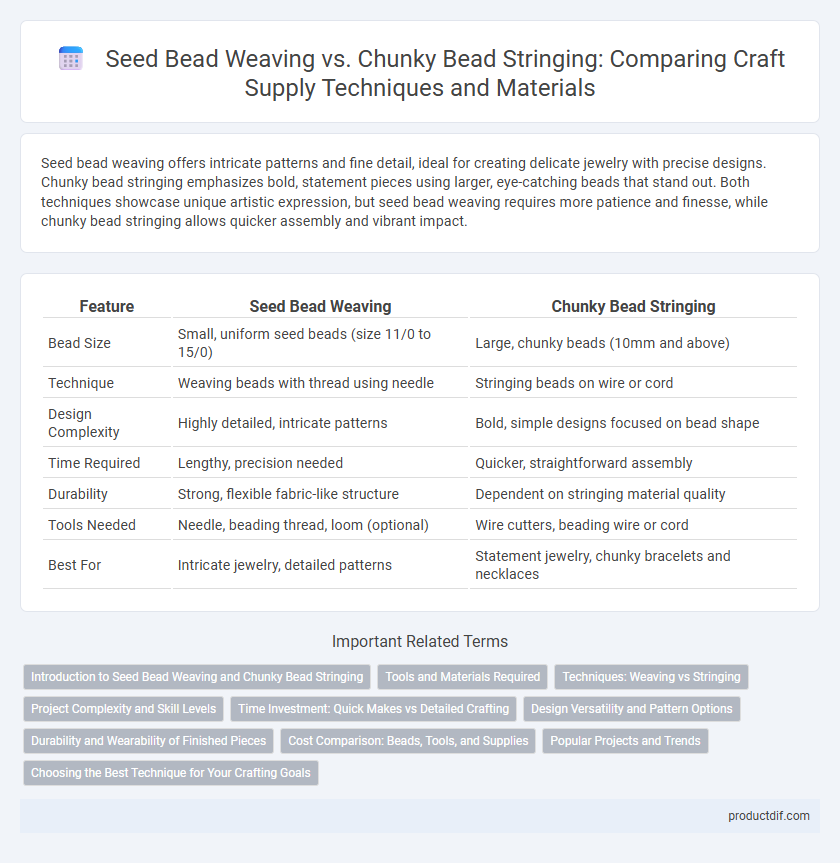Seed bead weaving offers intricate patterns and fine detail, ideal for creating delicate jewelry with precise designs. Chunky bead stringing emphasizes bold, statement pieces using larger, eye-catching beads that stand out. Both techniques showcase unique artistic expression, but seed bead weaving requires more patience and finesse, while chunky bead stringing allows quicker assembly and vibrant impact.
Table of Comparison
| Feature | Seed Bead Weaving | Chunky Bead Stringing |
|---|---|---|
| Bead Size | Small, uniform seed beads (size 11/0 to 15/0) | Large, chunky beads (10mm and above) |
| Technique | Weaving beads with thread using needle | Stringing beads on wire or cord |
| Design Complexity | Highly detailed, intricate patterns | Bold, simple designs focused on bead shape |
| Time Required | Lengthy, precision needed | Quicker, straightforward assembly |
| Durability | Strong, flexible fabric-like structure | Dependent on stringing material quality |
| Tools Needed | Needle, beading thread, loom (optional) | Wire cutters, beading wire or cord |
| Best For | Intricate jewelry, detailed patterns | Statement jewelry, chunky bracelets and necklaces |
Introduction to Seed Bead Weaving and Chunky Bead Stringing
Seed bead weaving involves the meticulous interlacing of tiny, uniformly shaped beads to create intricate patterns and detailed designs, often using specialized looms or needle-and-thread techniques. Chunky bead stringing features larger, statement-making beads strung together to form bold and textured jewelry pieces, typically requiring strong thread or wire for durability. Both methods offer unique artistic expressions, with seed bead weaving excelling in precision and complexity, while chunky bead stringing emphasizes volume and visual impact.
Tools and Materials Required
Seed bead weaving requires specialized tools such as fine beading needles, threaders, and high-quality seed beads in various sizes and colors, along with bead looms or bead mats for precise pattern work. Chunky bead stringing involves larger beads made from materials like wood, glass, or acrylic and utilizes stronger materials such as nylon or leather cords, along with heavy-duty beading needles and clasps for durability. Both techniques demand distinct tools and materials tailored to the bead size and design complexity, influencing the final texture and flexibility of the craft piece.
Techniques: Weaving vs Stringing
Seed bead weaving involves interlacing tiny beads using thread and needle in intricate patterns, creating flexible and detailed designs ideal for jewelry and decorative crafts. Chunky bead stringing focuses on threading larger beads onto a string or wire, emphasizing bold, statement-making pieces with simpler construction. The weaving technique allows for more complex textures and shapes, whereas stringing offers quicker assembly and emphasizes bead size and color impact.
Project Complexity and Skill Levels
Seed bead weaving requires advanced skill and precision due to intricate patterns and tiny bead sizes, making it ideal for complex, detailed projects. Chunky bead stringing is more accessible for beginners, involving larger beads and simpler assembly, suitable for quick and bold designs. Project complexity in seed bead weaving demands patience and technique, while chunky bead stringing offers faster results with less technical skill.
Time Investment: Quick Makes vs Detailed Crafting
Seed bead weaving demands significant time investment due to its intricate patterns and precise threadwork, making it ideal for detailed crafting projects that require patience and skill. Chunky bead stringing offers a quicker alternative, with larger beads that can be assembled rapidly, perfect for fast makes and bold designs. Choosing between the two depends on whether the focus is on speed or detailed artistry in bead crafting.
Design Versatility and Pattern Options
Seed bead weaving offers exceptional design versatility with intricate patterns and detailed textures achievable through techniques like peyote and brick stitch. Chunky bead stringing emphasizes bold, statement-making pieces with larger beads, limiting pattern complexity but enhancing visual impact. Both methods provide unique aesthetic choices, with seed bead weaving excelling in detailed designs and chunky stringing favoring simplicity and size.
Durability and Wearability of Finished Pieces
Seed bead weaving creates tightly interlocked patterns that enhance durability and resistance to daily wear, making finished pieces less prone to breakage or deformation. Chunky bead stringing, relying on larger beads and thicker threads, offers substantial visual impact but may have slightly less flexibility, increasing the risk of thread stretching or bead detachment over time. When prioritizing wearability, seed bead weaving provides lightweight, flexible jewelry ideal for frequent use, whereas chunky bead stringing best suits statement pieces worn less often.
Cost Comparison: Beads, Tools, and Supplies
Seed bead weaving generally requires a higher initial investment in specialized tools such as bead looms, fine needles, and beading thread, while chunky bead stringing often involves simpler tools like sturdy beading wire and basic pliers. The cost of beads varies significantly, with seed beads priced affordably in bulk but needing larger quantities, whereas chunky beads tend to be more expensive per piece but fewer are required per project. Overall, seed bead weaving can become cost-effective for intricate designs, but chunky bead stringing offers a more budget-friendly and quicker setup for bold, statement jewelry.
Popular Projects and Trends
Seed bead weaving remains popular for intricate patterns and delicate jewelry like bracelets and earrings, favored in bohemian and vintage-inspired trends. Chunky bead stringing dominates statement necklaces and bold accessories, trending in contemporary fashion with oversized beads and vibrant colors. Both techniques are embraced for DIY craft kits and personalized designs, driving steady growth in handmade jewelry markets.
Choosing the Best Technique for Your Crafting Goals
Seed bead weaving offers detailed, intricate patterns ideal for delicate jewelry and complex designs, while chunky bead stringing emphasizes bold, statement pieces with larger beads that are quicker to assemble. Selecting the best technique depends on the desired aesthetic, project complexity, and time commitment, with seed bead weaving suited for fine craftsmanship and chunky bead stringing favored for vibrant, easy-to-make accessories. Both methods utilize diverse bead types, threads, and tools, making the choice crucial for achieving your specific crafting goals.
Seed bead weaving vs Chunky bead stringing Infographic

 productdif.com
productdif.com